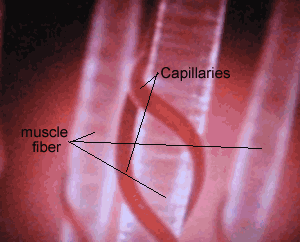The rate at which fuel is burnt depends on the athlete. An elite marathon runner is able to burn fat at twice the rate of non athletes. Similarly, elite sprinters can burn glycogen at twice the rate of normal individuals. Ofcourse the rate at which fuel is burnt in the body depends on the rate at which oxygen can be delivered to the working muscles.
Many systems need to work together at peak performance to achieve the desired outcome in athletes. For example, the lungs can put oxygen into the blood, however the heart must be able to transport it to the waiting muscles. The oxygen must then be mobilised by the muscle to enter the mitochondria quickly where it combines with glucose and or fat to produce energy. Improvements in oxygen transport can be trained and are the major reasons we can hope to improve our performance. The body responds in many ways to strenuous exercise. It is now generally recognised that skeletal muscle fibers do
not exist in three discrete forms, as described in another topic on muscle in this unit of work, but rather in a changing state based on a combination of a number of factors including, muscle protein(myosin, actin), metabolic potential, and calcium ion transport mechanisms. The plasticity of these cellular characteristics means that exercise can induce changes in cells that can transform them from slow twitch to fast twitch type and vice versa.

Some of the physiological responses to exercise are listed below.
- Increase in bone density, when involved in sports that require the muscles to pull heavily on bone such as impact sports and weight lifting.
- The heart increases in its capacity to deliver a greater volume of blood with every beat.
- Arteries and veins become more elastic able to carry a greater volume of blood without damage.
- More capillaries grow around muscle fibers, as shown on the right, so that a greater amount of oxygen can be delivered to the working muscle.
- An increase in the density of mitochondria found in muscle cells. These organelles are the energy factories of all muscle cells and indeed all the cells of the body. Mitochondria burn a fuel cocktail of fat and glucose.
- Extra glycogen is deposited in each muscle cell. Glycogen is the form that glucose is stored inside animal cells. It is found in liver and muscle cells. Athletes can store enough glycogen in their muscle cells for exercise of between 60 and 90 minutes.
- An increase in the amount of enzymes responsible for the metabolic process in each cell.

What are enzymes responsible for?
Some coaches talk about doing hard exercise to create "muscle memory". Does muscle have a memory? . From what you know, describe what happens when the muscle is exercised hard.